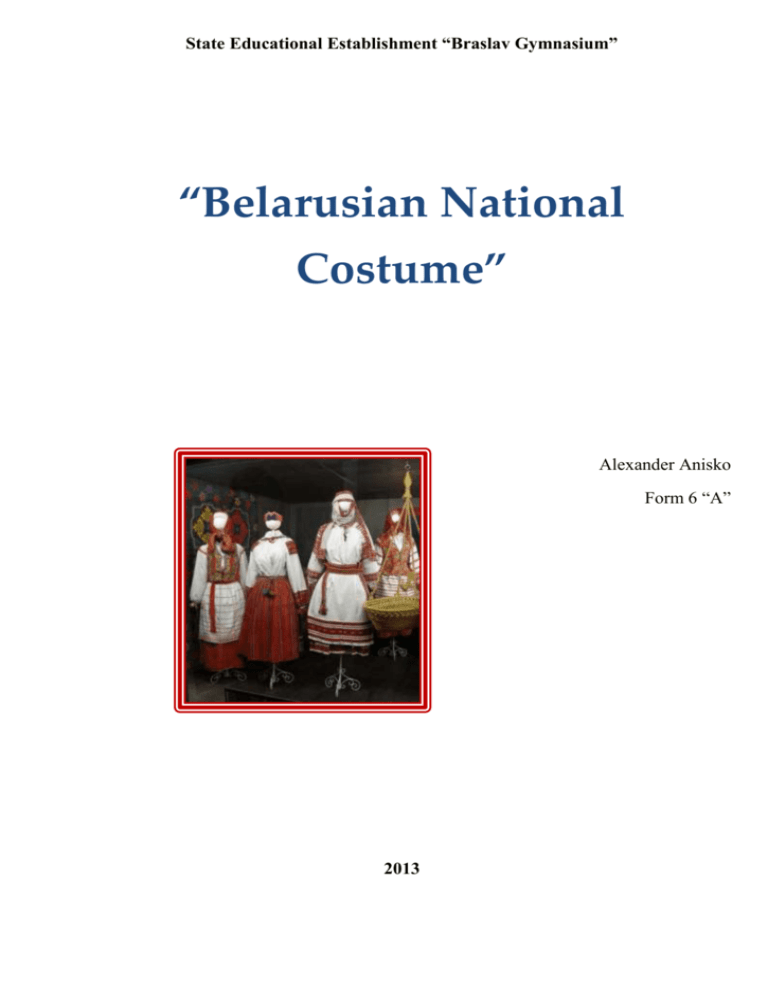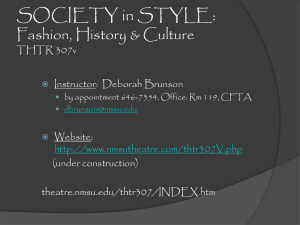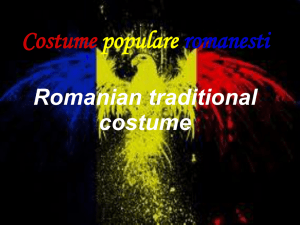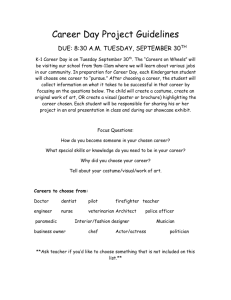Alexander Anisko_Braslav Gymnasium
advertisement

State Educational Establishment “Braslav Gymnasium” “Belarusian National Costume” Alexander Anisko Form 6 “A” 2013 Chapter 1.General description of Belarusian National Clothes Clothing is an important ethnic feature of the nation. The origins of Belarusian clothing tradition lie in the ancient KiewanRus'. The moderate continental climate, long winter and mild summer required closed warm clothing. Fabrics were made out of flux and wool, decorated with printed or embroiled ornaments, or weaved from using threads of different colour. The nobility were making their clothing mainly using imported fabrics - brocade, velvet, tuft - of different shades of red, blue, and less often green. The embroideries with silk and pearls were used as decorations. The general aesthetic requirement was static and simplicity of the silhouette. The basics of set of male clothing was had a shirt with a belt and trousers, female - a shirt (longer than male) and "paniova" type skirt. Outside clothing was usually a "svita" type coat often lined with fur inside for winter clothing. These features were transferred to the clothing in western lands of ancient Rus', where in XIII-XVI a Belarusian nationality was formed. The costume of Belarusians conserved it ties with costume of Russians and Ukrainians, but also acquired the features of our other neighbors - Poles, Lithuanians, Latvians and other European nations. The formation of Belarusian costume has coincided with the development of new, more complicated techniques of cut, the sophistication of dressmaking in Western Europe, which leaded to significant changes of European clothing. The shirt received more complicated cut, turn-down collar. Svita was improved by adding "vytacki"(pleets), oval cut in "proima"(collar) and sleeves. As Belarus is not such a big country, though there are 22 variants of the national costume of six regions - Central Belarus, Eastern and Western PolesiePonemane, Naddvine and the Dnieper. Regional differences are mainly in the details of costume, motives and subjects of ornament, how to wear the costume pieces in color. So in the old days by the costume you can determine what area the man is from, his marital status and even the approximate age. The ensemble of women's clothing consists of a shirt, a skirt, an apron, a belt, a vest and a hat. The shirt (kashulya) is sewed in linen homespun cloth. Woven or embroidered with patterns of red or red and black yarn it is usually decorated with sleeves, shoulders, collar, and cuffs. The skirt (spadnitsa) is woolen or linen with a variety of different colors and patterns (cell, lane). A white linen apron has the color and ornament that are in harmony with the decoration of the shirt. The bottom is often decorated with fringe or lace. The vest (gorset) is a part of a festive costume and is made of fabrics (silk, velvet, brocade). It could be black, cyan, magenta flowers, richly decorated with stripes. The belt can be woven, braided or knitted, and a variety of colors, but most of the green-white-red. It is richly decorated with ornaments. 2 Chapter 2. Some Facts from the History of Belarusian National Costume The clothing of "mahnat"(big landlords) and city aristocracy was developing within the Western European tradition. It was made out of expensive fabrics, decorated with golden and silver embroidery, precious stones, colored buttons. The important composites of male dress were satin "zhupan"(a dressing gown) with "kuntush"(coat, caftan?) on top of it, a long belt, wolf or beaver fur. The female clothes included "fereziia", "hazuka", "chamara"(different types of blouse), decorated on the sides with ornaments or the fur of sable, marten or fox. The aristocratic clothing has started to simplify at the end of XVIII c. Here you can see an example of the aristocratic clothing reconstruction as it was in XVIXVII cc demonstrated in the court of Radzivil's Castle in Niasvizh. The folk dress was influencing the costume of aristocracy and was influenced itself by an aristocratic clothing. The Belarusian costume of XVI-XVI c was enriched with new elements like "andarak" (a type of coat), "harset" (a type of top blouse) and with new principles of wearing - the techniques of tying. The silhouette became tighter to figure and was more reflecting Renaissance attitude to the world. The tendencies in costume at this time were general strictness, majority of white color in some elements, traditional combination of white and red colors, geometrical ornaments - in accordance with the eastern-Slavic tradition of clothing. The further development of Belarusian Ian costume in XVII c.-middle XIX c. did not had any cardinal changes and was undergoing rather moderate evolution of different elements. It was mostly reflected in the saturation of colors, rethinking of ornamental motives and development of regional traditions. Until the middle of XIX c. Belarusian costume was having clearly ethnical character. In fact it was a type of the folk art. One of the important features was the traditional division of different types of clothing for different activities. There was a clear division of clothing into categories used for dressing during weekdays or holidays, weddings or birthdays, during celebrations or mourning. For example during the religious "fast" folks were dressed in a special "fasting" clothes, where red color (traditionally designating "life, joy" among Slavs) was absent. The most beautiful clothes were worn to different labor holidays - Festive first taking out cattle on spring meadows ("naYurauskuiurasu" - touching the dew of Yuria, ancient pagan God of Sun, who starts spring), the holidays of the First furrow ("Pershaiabarazna"), First sheaf in the field ("Piershysnopnanivie"), First hay harvest ("Piershypakosnasienazhaci"). The costume was matching harmoniously Belarusian landscapes, the interior of Belarusian houses and its original furniture, "rushniki" (decorative towels), "abrusy" (wooden ornaments on the house). The textiles were made at home using "krosna" wooden textile weaving device with handheld shuttle. The dyes used were natural - grass extracts, cork and leaves of the trees, swamp iron ore. The white fabric was either printed or embroiled with ornaments. Red color was often used to combine different elements of 3 costume into one ensemble. Woolen and semi-woolen fabrics were usually polychromatic - combinations of red, green, blue and white colors, so it was rarely embroiled. The natural texture and shine of flax was used for decorative purposes. There was also a specific craft of fabrics decoration - printing ("nabivanka"). Beginning from the second half of XIX c. the invention of aniline dyes and fabric manufacturing of threads the traditional spectrum of colors was broadened. Traditional male clothing ensemble incorporated a shirt, pants and waistcoat (camisol). The shirt was worn on outside pants fastened with colorful belt. The footwear was ranging from bastshoes ("luptsi") to tall leather boots ("boty"). But the artistic fantasy and craftsmanship reached its peak in making female clothing marking the general ethnic character of Belarusian costume. Extreme attention was devoted to decoration of sleeves. It was believed that the bright red rhombic ornaments have magical powers. Thus the hands of working women were protected from spells and bad spirits by decoration of their sleeves with such ornaments. The upper clothing was usually decorated with squares or stripes (longitudinal or transverse) in a red, blue-green or silver-white shades. A closely fitting sleeveless cardigan (‘garset’) was often a part of women's clothing (especially festive clothing). It was usually made out of velvet, brocade, tuft or silk of a black, blue, raspberry colors and decorated with embroidery, application of braids buttons. The obligatory part of every costume was multi-color (most frequently red-green) belt with pompons, tassels or fringes. The women's' and men's' coats did not differ much. It was usually made from felt under wool ("svita", "siarmiaha", "latooshka", "boorka", "boornos"), sheepskin ("kazhooh", ""kazhooshok") - first un-tanned white, later red-ochre tanned. At the end of XIX c - beginning of XX c the polarization of society, development of economy and industry have brought wide spectrum of changes to Belarusian costume. New types of fabrics, mostly industrially manufactured have made their way to the countryside. The men's clothing became more complex and diverse. Semi-shades of colors were now used instead of clear colors. The semantic tradition of geometric ornamental decoration was disappearing giving place to plant ornaments. Distinctive stylized pigeons, peacocks and other zoomorphic themes appeared while still blended into geometric ornaments in fabrics of Palesse and Slucak regions. In the middle of the XX c. new developments happen. The plane ornaments start to acquire 3D quality due to the use of multiple shades of the same colors. The folk clothing is by this time split in the series of the local ensembles significantly differing from each other. The most clearly defined styles are shown below divided into major geographical regions: central Belarus. Nioman river region ("Paniamonnie"), Western and Eastern Paliessie, Dnieper river region ("Prydnieprouia") and Dzvina river region ("Nadzvinnia"). 4 The clothing of central Belarus and Nioman river region (Paniamonnie). Styles are named by the geographical regions: puhavichski style (1), liahavitski style (2), kapyl'ska-kliotski style (3), slutski style (4), vileiski style (5), 5 mastouski style(6), navahrudski style (7), vaukavyska-kamianietski style (8-9). 6 The folk clothing of Palesse (Southern lands of Belarus and Northern lands of Ukraine): damachouski style (10), malarytski style (11), kobrynski style (12), pinski style (13), motal'ski style (14), 7 davyd-haradotska-turauski style (15), turava-mazyrski style (16), kalinkavichski style (17), brahinski style (18). 8 The clothing of Dnieper river region (Prydneprouia) and Dzvina river region (Nadzvinnia): mahilyowski style (19-20), krasnapol'ski style (21), buda-kashaleuski style (22), nehliubski style (23), 9 lepel'ski style (24), dubrovenski style (25), astravietska-dzisnenski region (26-27). Students from Braslav Gymnasium, Belarus Coordinator Teacher: Olga Luksha 10






